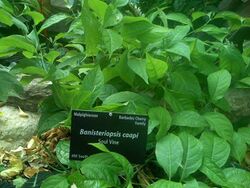Banisteriopsis caapi
| Banisteriopsis caapi | |
|---|---|
 |
|
| Taxonomical nomenclature | |
| Kingdom | Plantae |
| Unranked | Angiosperms |
| Unranked | Eudicots |
| Unranked | Rosids |
| Order | Malpighiales |
| Family | Malpighiaceae |
| Genus | Banisteriopsis |
| Species | B. caapi |
| Common nomenclature | |
| Common names | Ayahuasca, Caapi or Yagé |
| Constituents | |
| Active constituents | Harmala alkaloid |
Banisteriopsis caapi, also known as ayahuasca, caapi or yagé, is a South American liana of the family Malpighiaceae. It is used to prepare ayahuasca, a decoction with a long history of its entheogenic use and its status as a "plant teacher" among the indigenous peoples of the Amazon rainforest.
History and culture
Research
Neurogenesis
The alkaloids of Banisteriopsis caapi, the plant source of the Amazonian hallucinogen ayahuasca, stimulate adult neurogenesis in vitro.[1]
Chemistry
Banisteriopsis caapi (also known as ayahuasca, caapi or yajé) is a South American jungle vine of the family Malpighiaceae. It contains harmine, harmaline, and tetrahydroharmine in the following proportions:
- Harmine: 0.31-8.43%
- Harmaline: 0.03-0.83%
- Proanthocyanidins (less known MAOIs)
- (−)-epicatechin
- (−)-procyanidins
- Tetrahydroharmine: 0.05-2.94%
Toxicity and harm potential
Dangerous interactions
Cholinergics
Cholinergic substances combined with Banisteriopsis caapi can cause a cholinergic crisis because the plant contains acetylcholinesterase inhibitors (AChEIs):
See also
External links
- Harmala alkaloids
Literature
- Morales-García, J. A., de la Fuente Revenga, M., Alonso-Gil, S., Rodríguez-Franco, M. I., Feilding, A., Perez-Castillo, A., & Riba, J. (2017). The alkaloids of Banisteriopsis caapi, the plant source of the Amazonian hallucinogen Ayahuasca, stimulate adult neurogenesis in vitro. Scientific Reports, 7(1), 5309. https://doi.org/10.1038/s41598-017-05407-9